Chugging Along With American Flyer
Trains
by Bob Brooke
QUESTION:
I got an American Flyer toy freight
train for Christmas when I was kid. I loved that train. My dad and I
used to get it out each year and set it up under the Christmas tree,
complete with little houses and even a tunnel which the train entered as
it went under the back of the tree. As I got older, I began to buy other
trains and accessories with money I had saved up. By the time I was in
my teens, I moved my trains to the basement where I created my own world
in miniature. I still have those trains and accessories and now would
like to know more about them. What can you tell me about American Flyer
trains? Are they worth collecting?
Thanks,
Henry

__________________________________________________________
ANSWER:
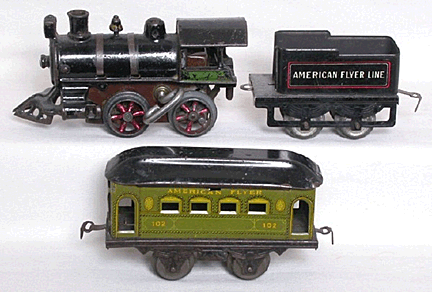 One
of the fastest growing fields of collectibles is toy trains, and those
from the post World War II era are especially hot. While Lionel trains
have dominated this segment for some time, American Flyer trains,
originally independently made and later on produced by A.C. Gilbert,
have been creating a stir among new and old collectors alike. One
of the fastest growing fields of collectibles is toy trains, and those
from the post World War II era are especially hot. While Lionel trains
have dominated this segment for some time, American Flyer trains,
originally independently made and later on produced by A.C. Gilbert,
have been creating a stir among new and old collectors alike.
The growth of post-war trains as collectibles harkens back to memories
of a youngster's first toy train racing around the Christmas tree on a
wintry morning, much like yours. Adults, like myself, remembering their
first American Flyer train, once again seek to purchase and own trains
of their own, but this time for a different reason--their collectibility.
Until 1891 most manufacturers and buyers tended to think of toy trains
as they would toy boats, tops, or other playthings--as objects complete
in themselves. Railways, however are different. They’re not just
individual toys, they’re systems.
It wasn’t until the Marklin Toy Company of Germany, presented three
different sizes of trains at the 1891 Leipzig Toy Fair that the idea of
using different gauges of track came into existence. Not only did they
produce different gauges, but, for the first time, accessories to go
with their trains.
Soon after the introduction of the three gauges--the smallest, Gauge I
at 1 3/4 in., the next, Gauge II at 2 inches, and the largest, Gauge III
at 3 inches--Marklin brought out another gauge, known as Zero Gauge at 1
1/4 inches. Because a zero looked like the letter “O,” the new gauge
became known as O Gauge. From then on additional new gauges were given
letter designations--S, OO, HO, TT, N and Z.
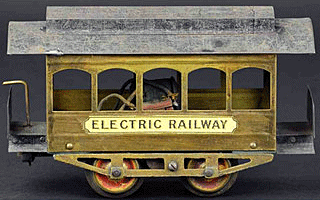 Up
to now, all toy trains were operated by clockwork windup motors. But in
1897, the obscure American firm of Carlisle and Finch, of Cincinnati,
Ohio, brought out a four-wheeled electric tram that was to revolutionize
the toy train industry. At first, a center rail conducted the electric
current, but the company dropped it in favor of the two-rail system. The
unexpected popularity of their electric trams encouraged the company to
expand its product line by adding steam locomotives and rolling stock. Up
to now, all toy trains were operated by clockwork windup motors. But in
1897, the obscure American firm of Carlisle and Finch, of Cincinnati,
Ohio, brought out a four-wheeled electric tram that was to revolutionize
the toy train industry. At first, a center rail conducted the electric
current, but the company dropped it in favor of the two-rail system. The
unexpected popularity of their electric trams encouraged the company to
expand its product line by adding steam locomotives and rolling stock.
Unlike the Germans and the British, the American train manufacturers
weren’t enthusiasts, also, so they didn’t care about scale likeness and
correct livery. Joshua Lionel Cowan, who founded Lionel in 1901,
produced a new 2 1/8inch gauge and christened it “Standard gauge.” Thus,
from then on, all other gauges produced by other manufacturers would be
designated “non-standard.”
American Flyer Beginnings
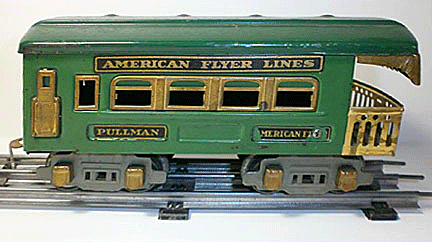 American
Flyer began in 1900 when William Hafner of Chicago, Illinois went into
business as a toy manufacturer. When Hafner decided to add windup
trains, he brought in a financial partner, William Coleman. Together
they founded the American Flyer Manufacturing Co. in Chicago in 1907 and
made windup and electric Wide gauge (the competitor to Lionel's Standard
gauge) trains, but fought against its image as only a producer of
economy toy train lines. By 1910 trains were the company’s strongest
product line, and, accordingly, they changed the firm’s name to American
Flyer. Hafner left in 1914. Coleman remained. American
Flyer began in 1900 when William Hafner of Chicago, Illinois went into
business as a toy manufacturer. When Hafner decided to add windup
trains, he brought in a financial partner, William Coleman. Together
they founded the American Flyer Manufacturing Co. in Chicago in 1907 and
made windup and electric Wide gauge (the competitor to Lionel's Standard
gauge) trains, but fought against its image as only a producer of
economy toy train lines. By 1910 trains were the company’s strongest
product line, and, accordingly, they changed the firm’s name to American
Flyer. Hafner left in 1914. Coleman remained.
Originally, the makers of American Flyer trains used tin-plate for their
rolling engines and rolling stock, lithographing details on almost
smooth surfaces. But as the buying public wanted--no demanded--more
detail on its toy trains, it switched to die-cast locomotives and cars,
more realistic, but still toy-like. In an effort to make its passenger
cars more competitive, American Flyer replaced its original passenger
coaches with ones decorated in the Lionel style--enamel paint, brass
window trim and name-plates.
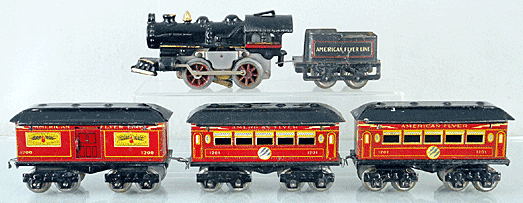
Until the 1920s, American Flyer had been content to compete in the
American market with cheap cast-iron wind-ups. After failing in the
British market with a special “British Flyer,” the company entered the
Standard Gauge market in 1925 with a line of large and good looking
equipment. For the first year, American Flyer bought passenger coaches
from Lionel, painting and lettering them for its own trains. But when
its own passenger stock came on the market, it aimed to compete directly
with its former supplier, its trains being larger and cheaper than
comparable Lionel trains.
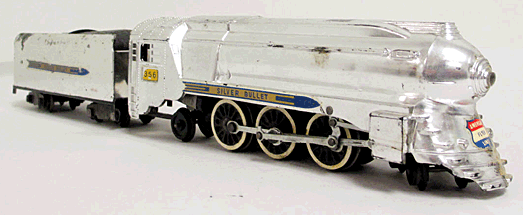
In the mid-1930's, however, toy train manufacturers in the U.S. received
an unexpected boost. Most people traveled by train and a new fleet of
streamlined trains caught the public’s imagination in a way that earlier
trains had not. The new streamliners, as they were called, were shiny
symbols of hope for millions struggling out of the Depression. Lionel
inaugurated a popular series of streamliners which proved to be good
sellers. American Flyer followed suit. Unfortunately, they weren’t a
success.
In 1936, in the midst of the Depression, in dire financial straits and
close to going out of business, American Flyer dropped its wide gauge
line.
Erector Set inventor A.C. Gilbert bought the company in 1937. The base
of American Flyer operations began to slowly shift from Chicago to New
Haven, where Gilbert started redesigning all the trains. Under its new
management, the firm scrapped its old trains and designed a new line
from scratch. Though made in O gauge, they were to a much smaller scale
and to a much higher quality. The finely detailed die castings and good
proportions were a great success with the public. And American Flyer was
reborn.

In 1939, Gilbert began to manufacture 3/16 scale, which were more highly
detailed and realistic-looking trains than any in the previous history
of toy trains. By 1941 the entire line was 3/16, which, despite its
heightened realism, still ran on three-rail tracks. The company also
brought out smaller, or HO gauge , American Flyer trains with rails 16.5
mm apart and a scale of 1:87. However , World War II put a stop to
production and this size wasn’t revived after the War.
The end of World War II found almost all of the toy train companies
intact and prepared to put their pre-war lines back on the market.
Europe had been hit hard by the war, and austerity and the widespread
shortages of raw materials meant that recovery was slow for European
manufacturers like Marklin. New companies had started up, particularly
in Switzerland and Italy, but it was in the United States that toy train
makers like Lionel and American Flyer were in the best position to
resume full-scale production.
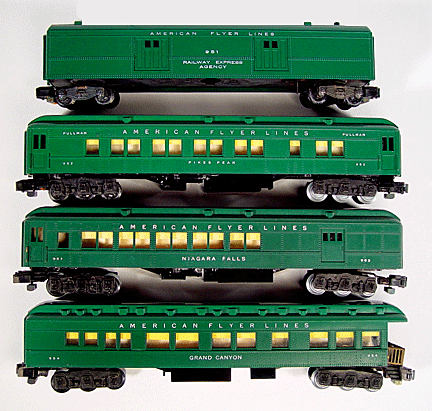 American
Flyer had the advantage of having in stock a line that had been
completely redesigned in 1938. Although the size was smaller than the
normal gauge 0 1:43 scale, the proportions and detail of the trains were
excellent. After the war, American Flyer reduced the distance between
the track to 24mm, so that the gauge was a better match for the scale,
and it christened the result "S" gauge and concentrated all its efforts
into producing the new "S" gauge trains. American
Flyer had the advantage of having in stock a line that had been
completely redesigned in 1938. Although the size was smaller than the
normal gauge 0 1:43 scale, the proportions and detail of the trains were
excellent. After the war, American Flyer reduced the distance between
the track to 24mm, so that the gauge was a better match for the scale,
and it christened the result "S" gauge and concentrated all its efforts
into producing the new "S" gauge trains.
The company continued to use tin-plate for the majority of its rolling
stock until the early 1950s. Post-war America had been turned upside by
the use of plastics and toy trains weren’t to be any different. Through
the use of detailed die-castings, American Flyer began to produce trains
that were at the same time light-weight, inexpensive, and realistic
looking. During the early 1950s, the trucks(wheel sets) on train cars
had chrome-like tin wheel covers and pointed arrow-like link couplers,
but by the late 1950s, the wheel covers were modeled in an overall gray
tone and the couplers had been changed to the more realistic knuckle
type. By the time the decade was over, American Flyer trains looked and
sounded like the real thing, complete with the livery of the top U.S.
railroads of the time and choo-choo sounds and smoke billowing from the
stacks of its steam locomotives. But what distinguished these trains
from others was what Gilbert labeled “Pul-Mor” power, a strength in the
engine motors that allowed them to pull more cars than their
competitors’ counterparts.
Lionel was even quicker off the mark than American Flyer, and it soon
had a sizeable catalogue of new trains, all of which made extensive use
of pressure die-castings. The old tin-plate look had vanished, as had
the streamliners from the Depression years. Gilbert dropped its previous
line and introduced accurately-scaled trains that moved by a two-rail
system.

America was enjoying a post-war boom, and Gilbert didn’t see any need to
diversify the American Flyer product line. The huge pent-up demand from
buyers who had been unable to afford toy trains during the Depression of
the 1930s and had been frustrated by the lack of production during the
war meant that neither American Flyer nor Lionel had to hunt for
customers. Both companies began a new program that emphasized automatic
accessories and electrical novelties. Almost all these new accessories
"did" something. One of the most popular was a refrigerator car, from
which a trainman inside unloaded miniature milk churns on to a loading
platform when a button was pushed. American Flyer also produced saw
mills that sawed logs into boards, barrel loaders, log loaders, a
station with baggage smasher that loaded baggage, a stockyard cattle
loader, and even a cow that walked onto the track which stopped the
oncoming train.
The company also brought out a series of “action” cars in 1958,
featuring freight cars that unloaded lumber and logs, dumped coal,
launched rockets, or had trainmen signaling from cabooses or walking on
top of boxcars. In 1961, Gilbert produced a motorized rocket sled and an
exploding T.N.T. boxcar, which at the press of a button, flew into
pieces with an explosive “WHOOM!” The new accessories were ingenious but
not very realistic. While popular with children, their toy-like
qualities didn’t please serious buyers who wanted to build realistic
railways.
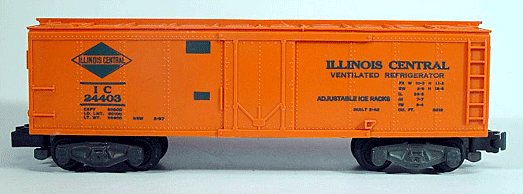
For 10 years Lionel and American Flyer enjoyed record sales and ignored
the developments that were taking place outside their own closed worlds.
But people everywhere were becoming much more interested in scale model
railroading and, by the mid-1950s, ready-to-run HO train sets had become
cheap and widely available. By 1950, all of Gilbert’s innovations had
pushed American flyer into sixth position among top makers in terms of
sales. However, a thorn in the firm’s side was its new two-rail S Gauge
trains, which never really took off.
The post-war toy train boom was suddenly over, and the sharp decline in
the sales of the relatively expensive O Gauge trains caught both Lionel
and American Flyer unprepared. Both firms tried desperate remedies, but
both went under. American Flyer stopped production, and Lionel trains
became a small, loss-making subsidiary of a large conglomerate. The long
era of American toy train manufacturing was effectively over.
In 1961 A.C. Gilbert died. Jack Wrather, owner of the T.V. series "The
Lone Ranger" and "Lassie" grabbed the trains. He cut back drastically.
Sales did rise 30 percent in 1965, but borrowed capital and production
costs offset the good news. In 1966, Lionel finally purchased its
long-time competitor, thus ending production of S Gauge American Flyer
Trains.. Three years later, General Mills became the new owner, with the
train production that had ended with Lionel’s purchase resuming, but on
a limited basis.
Identifying American Flyer Trains
Identifying American Flyer trains is easy, since every piece ever
produced has emblazoned on it a big three (early models) or five-digit
(later ones) product number and the name American Flyer. Greenberg’s
American Flyer Pocket Price Guide has become the “bible” for used
American Flyer products. It not only has all the price listings for all
the S Gauge / Flyer materials, including Gilbert, Lionel/Flyer, but it
also explains how to “Grade” trains and tells how much to expect from a
dealer.
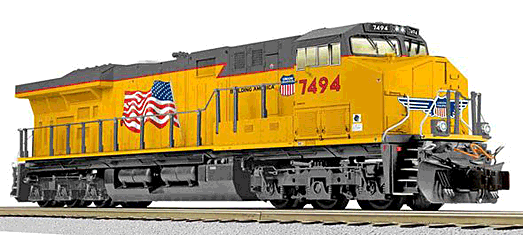
Among the more popular Flyer S-gauge trains among collectors today are
the series of aluminum-like diesels produced in the 1950s, especially
those that came with streamlined passenger cars. These were the
top-of-the-line Flyer trains of their day and remain the most visually
pleasing. Condition of the exterior of the trains counts a lot. Another
popular locomotive is the 4-8-4 Northern steamer, also known as the
“Challenger,” the biggest Flyer made. Of course, there are some less
visually exciting pieces and operating accessories that are much more
valuable because of scarce production numbers, such as the No. 21004
Pennsylvania R.R. switcher engine which originally sold for $27.50 and
is now worth over $400 in excellent condition, and the automatic coal
loader which sold for $19.95 and is now worth over $300 in excellent
condition.
<
Back to Readers Ask Archives
Next Article > |
